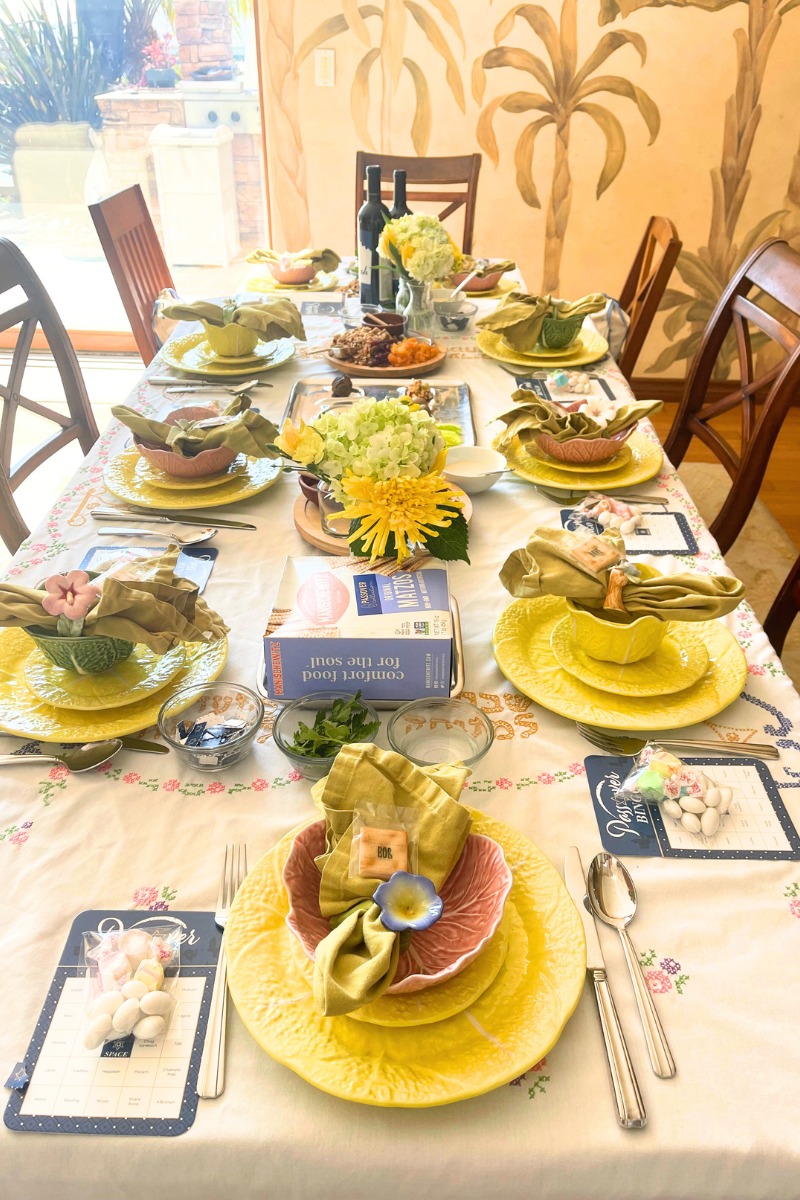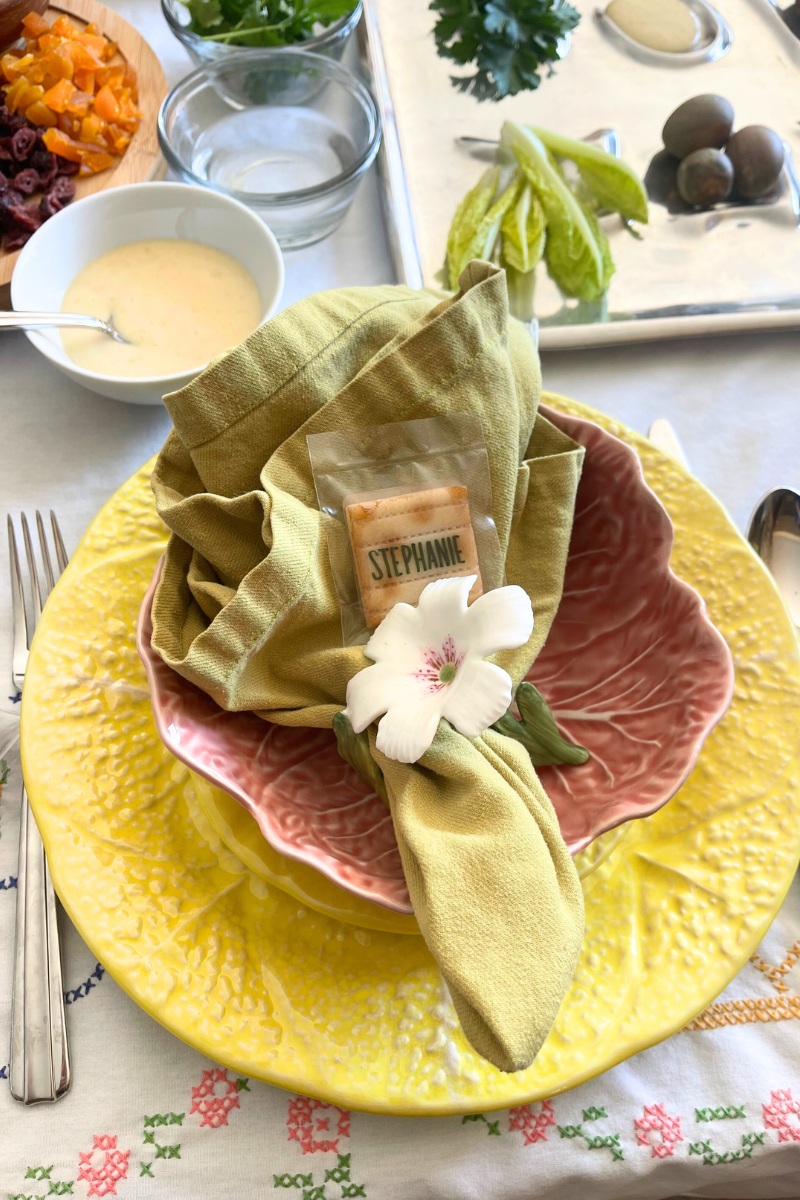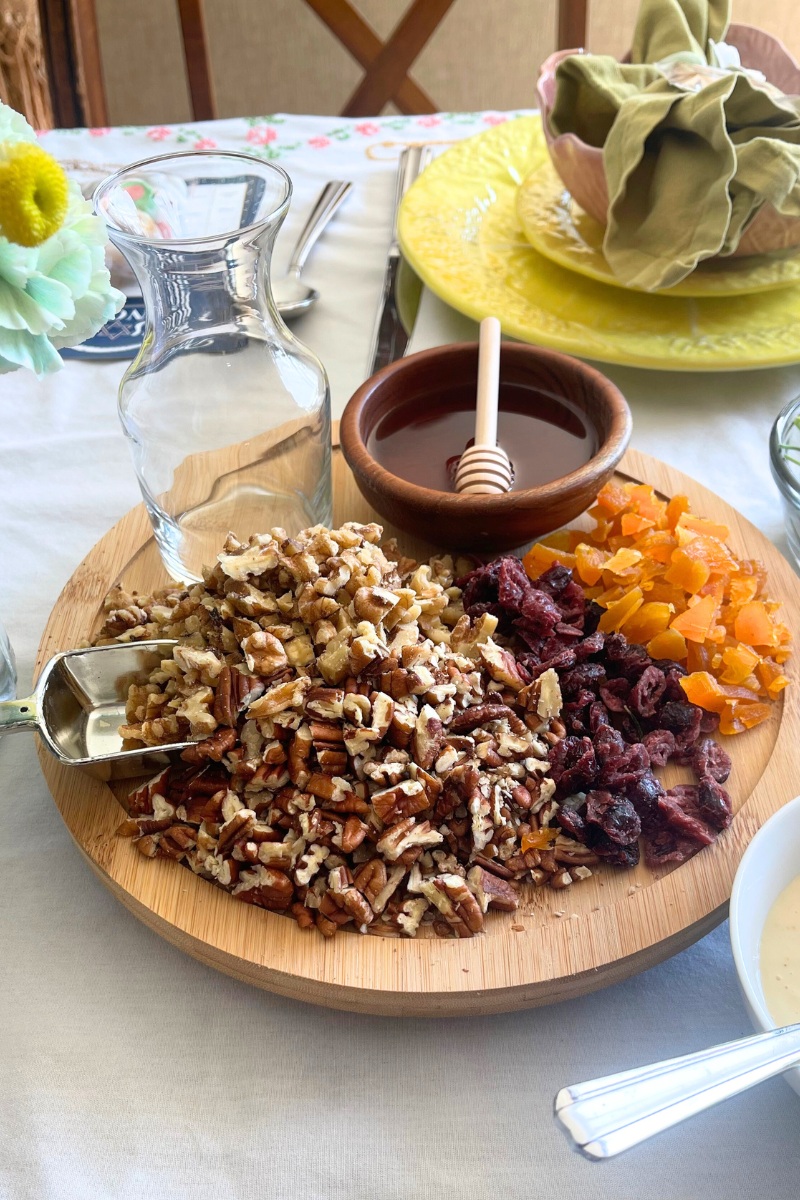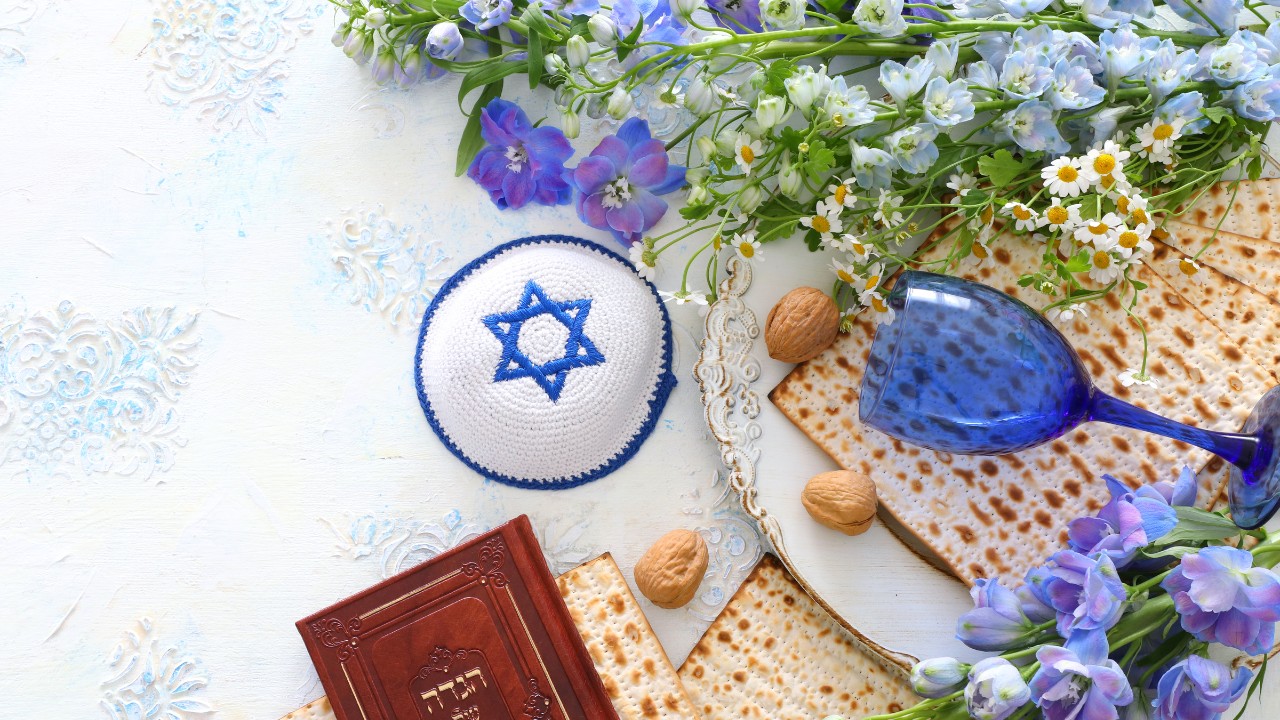Your go-to guide for hosting a vegan Passover Seder that honors tradition without compromising your plant-based ideals.

Passover is my favorite Jewish holiday. (I often refer to it as “Jewish” Thanksgiving.) The holiday is a time of remembrance and celebration, marked by rituals steeped in history and meaning that recount the Jewish people’s exodus from Egypt, out of slavery and into freedom. As a vegan, this theme of freedom is especially relevant and invites us to join in a commitment to ending slavery everywhere – including the animals in our home and on our plates.
Passover As a Vegan in a Non-Vegan Family
Although especially relevant in theme, incorporating veganism into this traditional feast (called a Seder), the holiday can pose a unique set of challenges, especially when you are a vegan in a predominantly non-vegan family. From the Seder plate to the main courses, each element of the meal traditionally includes non-vegan items, making it difficult to balance personal dietary choices with familial expectations and traditions. As I mentioned above, this is my favorite holiday, and I always host at least one of the first two nights of Seders. I go all out and love the opportunity to curate a menu and infuse the Haggadah with fun activities that tell the story of Passover.
I curated this blog post to help you navigate these challenges as a vegan in a non-vegan family, offering practical tips on how to host a Passover Seder that remains true to both the spirit of the holiday and your vegan lifestyle. Whether you’re a seasoned vegan or just looking to incorporate more plant-based options into your holiday gathering, this guide will provide you with the tools you need to host a memorable and respectful vegan Passover Seder where the traditions and spirit of the holiday are celebrated and honored without compromising your plant-based ideals.
Understanding Passover Dietary Restrictions
Passover is a holiday rich with symbolic foods and dietary restrictions, the most notable of which is the omission of “chametz” (leavened bread and other fermented grain products). This tradition commemorates the Israelites’ hasty departure from Egypt, leaving no time for their bread to rise. For eight days, many Jews avoid chametz, opting instead for matzo (unleavened bread) and other permissible foods that meet the criteria of Kosher for Passover.
In addition to avoiding chametz, many Ashkenazi Jews also refrain from eating kitniyot (legumes, rice, and similar foods) during Passover. However, this custom has seen variations and leniencies in modern times, particularly among Sephardic Jews and those who follow more liberal Jewish movements.
The key to a successful vegan Passover is understanding these layers of dietary restrictions and finding ways to navigate them without compromising the dietary laws or the integrity of the celebration. For instance, many of the traditional Passover dishes can be adapted using plant-based ingredients, ensuring they are both kosher for Passover and vegan. Personally, I select recipes that embrace the spirit of Passover, which is fundamentally about freedom—echoing the freedom that veganism seeks in its advocacy for animals.
By carefully selecting ingredients and preparing foods that honor these principles, you can create a Passover menu that is inclusive, respectful, and delicious. This preparation not only makes the meal enjoyable for you as a vegan but also accessible and appealing to your non-vegan family members, ensuring everyone can partake in the joy and unity of the Seder.
Preparing Your Non-Vegan Family
Hosting a vegan Passover Seder when your family is not vegan requires consideration and thoughtful preparation. Communication is key, and it’s important to approach the topic with sensitivity and understanding. Here’s how you can prepare your family for a different kind of Passover celebration.
Communication is Key:
Start by informing your family about your plans to host a vegan Passover well in advance. This gives everyone ample time to understand the changes and discuss any concerns they might have. Be open about your reasons for choosing a vegan lifestyle and how you plan to incorporate it into the Passover traditions. Providing context can help in making the transition smoother and more acceptable to all.
Educate and Inform:
There might be misconceptions or misunderstandings about what a vegan diet entails. Take the opportunity to educate your family about veganism. Explain the health benefits, environmental reasons, and ethical foundations that guide your dietary choices. You can share articles, books, or even documentaries that thoughtfully explain these aspects. The goal is not to convert them but to help them understand your perspective.
Highlight Common Ground:
Focus on the common values and traditions that bring you together for Passover. Emphasize how veganism also respects the themes of Passover, such as liberation and renewal, by promoting compassionate food choices. Highlight dishes that are traditionally vegan-friendly and explain how you plan to adapt others. This can reassure family members that they’ll still enjoy familiar flavors and foods, albeit in a slightly different form.
Involve Them in the Planning:
Engage your family in the meal planning and preparation. Ask for their input on dishes they love that can be easily veganized. You might also encourage them to help with the cooking or suggest vegan recipes they’ve come across. Involving them makes the celebration a collaborative effort and can increase their openness and excitement about the meal.
Respect Their Feelings:
Be prepared for resistance or skepticism. Change can be challenging, especially when it touches on deeply held traditions like those observed during Passover. Listen to their concerns with empathy and patience. Reaffirm that the essence of Passover, the gathering of family and the recounting of shared history, will remain intact.
By preparing your non-vegan family with openness, information, and inclusion, you pave the way for a Seder that respects both your vegan lifestyle and the cherished traditions of Passover. This approach not only fosters understanding but also strengthens family bonds in the spirit of the holiday.

Planning Your Passover Menu
Planning a vegan Passover menu that satisfies both vegan and non-vegan preferences is very achievable with a little bit of planning and creativity. Just as I teach in my regular dinner planning, prepare one same plant-core meal that everyone can enjoy, while providing options for non vegans.
Instead of forcing the majority of the group to eat a completely plant-based meal, I encourage you to meet people halfway with a compromise when it comes to the menu. I include two options for a main dish (vegan and non-vegan), and keep the rest of the meal completely vegan for anything I am cooking.
I choose this approach based on experience. When I first went vegan, I insisted the whole meal was vegan. It resulted in a lot of angst, anger and dissatisfaction from the non-vegans who were looking forward to celebrating their holiday. Talk to your family about the dishes that mean the most to them and whether they are open to a non-vegan version. Matzo ball soup, for example, is a Passover staple, and very different in texture and taste from a vegan version. Also, while most non-vegans are open to some vegan options, I have found it’s best to include a main that is familiar to non-vegans. Of course, if your family is willing to do the whole Sedar 100% vegan, go for it!
Here are a few steps to help you plan your menu.
1. Choose a main dish that can be adapted for both vegans and non-vegans.
Start with a plant-based main course that you can easily prepare alongside a non-vegan version of the same. For example, the marinade for a lemon-rosemary baked tofu or orange-glazed tempeh, could be doubled and used for chicken breasts in a separate pan. In the past, I have also had my husband pick up some roasted chickens to serve for the non-vegans so I didn’t have to be involved in any non-vegan prep.
2. Add complementary plant-based side dishes.
Once I have determined my main dish, I choose 2-3 grain and vegetable dishes that pair nicely with it, including a salad. I select recipes with familiar ingredients, such as Spring vegetables, potatoes and salads versus plant-fare with pantry items that may be new to non-vegans (such as tempeh, miso, etc.). I aim for elevated versions of traditional Spring ingredients.
3. Include vegan versions of traditional holiday fare.
Round out the meal using easy vegan swaps in traditional dishes where no one will notice the difference. For example, in the traditional “haroset”, an apple and nut mixture, honey is used. Swap it with agave and no one will notice.
4. Invite guests to bring traditional recipes that aren’t vegan.
If traditional matzo ball and kugel recipes are must-haves for your guests, invite the guest with the preference to bring it to share. Otherwise, be clear in your boundaries as to what you are comfortable preparing and not preparing for the meal.
Here are some ideas for each course that can help you prepare a festive and inclusive Seder meal.
Starters and Sides
- Vegan Matzo Ball Soup: Traditional matzo ball soup can be made vegan by using vegetable broth and matzo balls made from matzo meal, oil, and a binding agent like aquafaba (the liquid from canned chickpeas) instead of eggs. Try this recipe.
- Charoset Without Honey: This sweet, fruity dish usually contains honey, but you can easily substitute it with agave nectar or maple syrup to keep it vegan. Mix chopped apples, walnuts (or almonds), wine, and cinnamon to maintain the traditional flavors. Try this recipe.
- Gefilte “Fish”: Create a plant-based version of this classic appetizer using finely ground chickpeas or another white bean, blended with seaweed flakes to mimic the fishy flavor, shaped into patties, and boiled in a vegetable broth. Other options include vegetables such as potatoes and cauliflower. Try this recipe.
Main Courses
- Vegan Brisket Alternatives: Jackfruit and seitan make excellent substitutes for brisket when cooked with traditional seasonings like garlic, onion, and paprika, and simmered in a rich tomato-based sauce. Try this recipe or one of these main dish ideas.
Desserts
- Vegan Flourless Chocolate Cake: Made with dark chocolate, sugar, coconut oil, and almond flour, this rich cake is a delightful end to the meal that requires no modifications to be Passover-appropriate and vegan. Try this recipe.
- Macaroons Made with Aquafaba: Instead of egg whites, use aquafaba to bind the coconut flakes together. Add vanilla extract and a bit of sugar for sweetness to create these chewy, delicious treats. Try this recipe.
Sample Passover Menu
Below is the menu that I served my family for Passover last year. I share it to inspire you with ideas to curate your own menu. I change up what I’m serving each year but keep the traditional dishes such as matzo ball soup. Please note that I don’t observe kitniyot (refrain from eating rice and legumes), nor does my family.
- Vegetable and dip platter (store-bought hummus and Bitchin Sauce)
- Matzo ball soup: My daughter made the traditional non-vegan soup. I have not found a vegan matzo ball soup that replaces the traditional version with the same flavor and texture to make it worth the amount of work involved to serve just me so I usually skip the soup for me. This year, I might give this recipe or this one a try.
- Lemon Rosemary Chicken and Vegan “Chicken”: I veganized this recipe from Half Baked Harvest’s cookbook. I made the saucy beans separately, while also marinating the chicken and vegan Gardein Scallopini separately. (You could also use tofu steaks.) To serve, I plated the chicken and Gardein on different dishes and divided the saucy beans among them.
- Herb and Mustard Potato Stacks: I subbed vegan Parmesan in this recipe from Half Baked Harvest.
- Pesto Brussels Sprouts: This recipe from Veggies Save the Day was a fun Spring alternative to this veggie.
- French Lentil & Arugula Salad with Herbed Cashew Cheese: This recipe from Food 52 is easy and elegant, especially because I purchased store-bought vegan cheese instead of making my own.
- Vegan matzo bark: I made several batches of this with several toppings (almonds, pistachios and dried fruit, etc.). Use Google to find a variety of recipes.

Adapting Passover Rituals
Adapting traditional Passover rituals to incorporate vegan values has deepened the holiday’s themes of freedom and renewal in my family. I write my own Haggadah (the “storybook” that tells the story of Passover) and update it every year as my children have grown up so that the activities and songs are age appropriate. Here are some ideas for modifying the Seder plate and other Passover rituals to align with a vegan lifestyle while maintaining their symbolic meanings.
The Seder Plate
With the exception of two items on the Seder plate, everything is already vegan. You can easily veganize these symbols as follows.
- Z’roa (Shank Bone): Traditionally, a lamb shank bone represents the Passover sacrifice. As a vegan alternative, I use a beet, which I roast.
- Beitzah (Egg): The egg symbolizes the festival sacrifice and the cycle of life. For my vegan Seder plate, I use an avocado to represent life and renewal.
The Four Cups of Wine
I have turned this traditional part of the Seder into a wine “tasting” of vegan Kosher wines. It offers a fun “break” during the program.
DIY Charoset Bar
Charoset is a mixture of apples, nuts, spices and honey, and is traditionally served with matzo to symbolize the mortar and brick used by the Hebrew slaves to build the structures of Egypt. For the past couple of years, I have served this DIY style, placing bowls of various chopped nuts, a medley of different kinds of chopped apples, agave, and spices on a lazy Susan for everyone to customize their own charoset mixture.
The Passover Plagues
For each of the ten Passover plagues, I create candy bags for each of the children at my Seder using vegan candy to represent each of the plagues. In past years, I have also created a candy bar with takeaway bags for each guest to make their own candy bag to take home.
Some ideas for vegan candy include:
- Blood – Red sour straws
- Frogs – Sjaaks Chocolate frogs
- Lice – Dark Dhocolate non pareils
- Flies – Vegan chocolate covered raisins
- Livestock pestilence – Sour Patch Bunnies
- Boils – Fruit sours
- Hail – White gum balls
- Locusts – Gummy worms
- Darkness – Dark chocolate bar
- First born – Ring pop (because it looks like a pacifier)
Resources for Hosting Passover As A Vegan in a Non-Vegan Family
Below is my personal curated list of cookbooks, blogs and websites that I use to guide and inspire my own Passover planning.
Cookbooks
Blogs and Websites
- Tori Avey’s Food Blog: Known for exploring the history behind traditional Jewish dishes, Tori offers a range of recipes that can be adapted for a vegan diet.
- Modern Tribe: I love shopping this site for items and accessories for all of the Jewish holidays.
- What Jew Wanna Eat: Amy Kritzer shares modern Jewish recipes that are inventive and refreshing. Although not vegan, they can easily be adapted and offer lots of inspiration for menu planning.
- World of Vegan: This is a great vegan resource, in general, but I’ve also contributed many articles to this website over the years and highly recommend all of their content.
- Vegan Essentials: This online store offers a wide range of vegan products, some of which are kosher for Passover. Check their seasonal section during the Passover period for specific items.
Hosting a vegan Passover Seder in a non-vegan family environment can seem daunting, but with a little planning, I hope you find it to be as deeply rewarding as I have. The values and themes of freedom and compassion lend themselves nicely with my reasons for going vegan, providing a wonderful landscape to share my lifestyle choices with my friends and family.
During each Passover Seder, my goal is to not just to share delicious vegan food, but also create an opportunity to teach and learn while blending ancient traditions with modern values. May your vegan Passover Seder be a beautiful, enriching experience that contributes to a greater appreciation of vegan values intertwined with the rich tapestry of Passover traditions. Chag Sameach!

